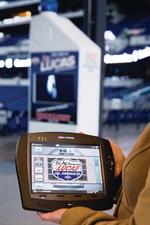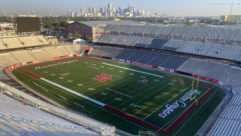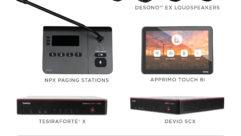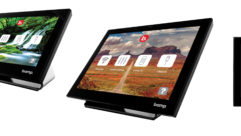

Controls Systems in Modern Stadiums
Modern sport stadiums aren’t what they used to be. They’re multipurpose venues whose AV systems must accommodate a wide variety of tenants. The control systems have changed, too.
Modern stadiums are a far cry from the sporting arenas of the past. They are multipurpose entertainment meccas that house restaurants, bars, and retail shops in addition to the playing field and seating bowl. Difficulty working on such large construction projects are compounded by the various AV needs throughout the stadium. As a result, stadium operators rely more and more on control systems to automate tasks, increase efficiency, and bring uniformity to stadium operations.
Sumanth Rayancha, chief technology officer at control system programming firm PepperDash Technology Corp., says joining a stadium project isn’t any different than smaller projects.
“We are usually brought in by the AV consultant or systems integrator,” he says. “However, I am seeing a change in when we’re brought on board for really big projects. We’re being brought in earlier, at the design phase, sometimes by the architect or building owners. Historically, control systems were a small portion of the project, but that is changing.”
Why? “The AV equipment is becoming more complex, so control systems must be more complex too,” he explains. “For example, the recording decks for pro video are specialty computers with multiple channels. Years ago, a stadium recording deck used to be a Betamax machine.”
Rayancha points to the new Yankee Stadium as an example of a modern stadium project. “We worked with one AV consultant, but there were three systems integrators on the project. The stadium project included team offices, boardrooms, conference rooms, restaurant and bar systems, and then the stadium systems that are tied into the broadcast system,” he says.
Another point he makes is that control system design is tricky in stadiums because broadcast professionals don’t like automation. “So the goal is to build a consolidated user interface of their equipment and give them one place to access their racks of equipment,” he adds. “It’s different thinking because the AV equipment is in the hands of professional technical operators. They want something they’re used to but that also makes their lives easier.”
Controls Systems in Modern Stadiums
Modern sport stadiums aren’t what they used to be. They’re multipurpose venues whose AV systems must accommodate a wide variety of tenants. The control systems have changed, too.
Working with Broadcasters
Troy Morgan, president and co-owner of programming and design firm PanTech Design, has firsthand experience working with broadcasters in a stadium environment. His firm’s work on control programming in the new Dallas Cowboys Stadium included control for five on-field unmanned cameras. The director needed to operate (pan, tilt, zoom, and switch) all cameras using a touch panel and joystick. “Stadiums need consistency and reliability but also flexibility of venue,” he says. “Modern stadiums are multiuse venues that need to be configured on the fly.”
Keep it Simple
How to design touch panel interfaces for commercial installations
A Crestron TPMX-8X wireless touch panel is used to control the AV in Lucas Oil Plaza, part of Lucas Oil Stadium in Indianapolis.
Credit: Courtesy Sensory Technologies
When designing graphical user interfaces (GUI) for touch panel controllers in commercial AV installations, the most important thing to remember is to keep it as simple as possible. The reason for this is that end users will often be infrequent users, if not complete novices, and their lack of familiarity with the system calls for intuitive, simplified functionality.
For example, playing back a DVD in a boardroom doesn’t require anything more than the basic controls. Functions to change the audio settings or viewing angle only serve to clutter the interface and cause confusion. In this case, the design should be limited to the necessary functions to accomplish the intended task, such as buttons for play, pause, forward, and rewind. Limiting functionality also has the benefit of increasing available interface real estate, allowing for bigger, more identifiable buttons, and for grouping buttons into similar categories.
When labeling functional buttons, be sure to use verbs to clearly identify what the button does, such as “Open Drapes” and “Play DVD.” Care should be taken in labeling nonfunctional buttons, too. For example, if a room or venue has two or more TVs, labeling them “TV 1,” “TV 2,” etc., isn’t very helpful. A better way would be to take a diagram approach and label them by their location from the user’s perspective.
The overall interface design should offer conservative aesthetics. While in a residence a touch panel is a luxury item; in a commercial application it’s a tool to accomplish a specific task and should offer a straightforward design with minimal graphics and animations.
Finally, the interface should offer high contrast, making it easy to read in low light. In many applications the touch panel will be used in a dimly lit setting, such as a lecture hall or at a stadium restaurant. As an AV integrator, your job in designing GUIs is not to deliver a “wow” factor, but to offer the most simple control experience possible through a minimalist design.
Author Morgan Strauss is president of Guifx, a design studio specializing in touchscreen interfaces.
Morgan says that most integrators plan for the hardware design first, especially in big venues like stadiums. “Most people misunderstand the need for software design for a firm foundation,” he says. “The challenge with large systems is that software people need to be brought in earlier, not at the last minute. If the AV hardware is already chosen, our creative input comes with client communication about how the user interface behavior and layout can serve their needs.”
In a growing trend, stadiums are turning to IP networking to unify HVAC, security, lighting, and point-of-sale (systems, audio, and AV all under a single control system).
“The movement is headed in this direction, but there is no one software package that can do it all at this time,” says Fred Curdts, senior vice president of the Performance Venue Group at AVI-SPL. His group specializes in large construction projects and has completed approximately 45 stadiums and arena projects. “Cisco has established a presence in the stadium market via their IPTV products. They are also driving the trend that all devices should be on one network,” he says.
Justo Gutierrez, engineering manager for the Performance Venue Group at AVI-SPL, adds, ‘Control system’ is a generic term, especially in a large venue. There are lots of choices for control of subsystems, like DSP packages for audio and IPTV systems for video. Both manufacturers and marketing are driving convergence. More and more, we are seeing AV specifications that state AV devices must live on the network.”
Curdts notes, “Sound systems have been on Ethernet networks for over 10 years. They prefer their own network, although we are seeing a trend towards one network for everything.” (Read about the installation at New Meadowlands stadium in “The Mixing Bowl.”)
AV pros say it’s important to appreciate how far AV technology has advanced in such a short time and how that relates to control systems. When AVI-SPL first worked on the sound system in Baltimore’s Camden Yards, it was the early 1990s and Crown’s IQ System was still new. “A ‘Play ball’ button turned on the amps and a ‘Good night’ button shut it all down, and that was the extent of the control,” Curdts says. “Today, you can have control over 75 amplifiers with hundreds of channels spread out across a mile of walking distance.”
Moreover, Curdts says, the average stadium now has 1,000 displays, and some stadiums have twice as many screens or more. Only 10 years ago or so, someone had to manually turn them on and off. Now at stadiums and arenas with good integrated control systems, it’s done at the touch of a button.
In addition, Gutierrez says new regulations mean life safety and voice evacuation systems in a stadium must interface with the sound system. “Often, we will use the control system to monitor the signal chain, including the life safety system signals,” he explains. “In a large venue, interoperability and the user interface are very important. A control system can mask the complexity of these systems so that the operator can use it with ease.”










